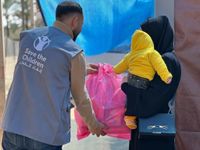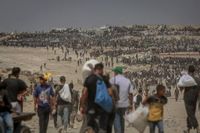In the wake of the devastating conflict that erupted on October 7, 2023, the Gaza Strip has become the epicenter of one of the world’s most acute humanitarian crises. The aftermath of the Hamas attacks that killed more than 1,200 people in Israel and saw over 200 hostages taken has been catastrophic for Gaza’s population. According to Broadview, more than 60,000 Palestinians have been killed since the onset of Israel’s siege, with an estimated 92 percent of buildings damaged or destroyed and about 90 percent of the territory’s population displaced. The destruction is nearly total, but the crisis goes beyond bombed-out buildings: a man-made famine is unfolding before the world’s eyes.
Starvation is now a daily reality for nearly two million Gazans. The Integrated Food Security Phase Classification (IPC) system, the international authority for measuring famine risk, reports that parts of Gaza have reached two out of three thresholds required to declare a famine. The IPC warned in July 2025 that Gaza is on the brink of phase five—catastrophe/famine—the final, most severe stage of food insecurity. There is no stage after this, and the consequences are already visible in the faces and bodies of Gaza’s children.
Between April and mid-July 2025, hospitals in Gaza treated more than 20,000 children for acute malnutrition, according to Broadview. The numbers are grim: 147 people, including 88 children, have died due to malnutrition and starvation as of late July. Roula Kikhia, a humanitarian adviser with Save the Children Canada, described the situation in stark terms: "The current situation in Gaza is beyond horrible and has also gotten worse. Our colleagues are telling us that they are seeing children and babies dying in front of them. So far, 147 people, including 88 children, have been reported dead due to malnutrition and starvation, and numbers are increasing every day. Let me be very clear here: this is a man-made crisis. This is the starvation of children by design; all of this could have been prevented."
Delivering aid in Gaza has become an almost impossible task. The Israeli siege—ongoing for more than four months as of July 2025—has severely restricted the entry of food, water, and essential supplies. Even when aid trucks manage to get through, they are described by Kikhia as "a drop in the oceans of the need." The barriers aren’t just about getting aid into Gaza; they’re about ensuring that desperate families can safely access what little is available. Kikhia criticized recent efforts like the Gaza Humanitarian Foundation, an American- and Israeli-backed initiative, for creating "militarized food distribution sites that people are risking their lives to go to."
The impact on children is especially harrowing. Aid workers in child-friendly spaces report that children are fainting from hunger and lack the energy to participate in basic activities. Some children, traumatized by the loss of family members and the constant threat of violence, have expressed a wish to die, believing that only in heaven will they find food and be reunited with loved ones. "We hear the children telling us that they want to go to heaven because there’s food in heaven. They are telling us that they want to die because they want to meet with their father or mother who was killed," Kikhia recounted to Broadview. The psychological scars of hunger and loss are likely to last a lifetime.
Despite these nearly insurmountable challenges, humanitarian organizations like Save the Children Canada persist in their efforts. Their clinics continue to operate, providing what care they can, and their local partners work tirelessly under constant threat. "Our team are risking their lives every day to keep working and supporting children, pregnant and breastfeeding women, families and caregivers so they can have access to the services," said Kikhia. Yet she stressed that humanitarian aid alone cannot resolve the crisis: "The only way we can put an end to mass starvation is through a definitive ceasefire and the re-establishment of conditions for the humanitarian system...to work at their full scale."
International responses have so far fallen short of what’s needed. Canadian Foreign Affairs Minister Anita Anand announced increased funding for humanitarian aid during a two-state conference in New York in 2025, a move welcomed by Save the Children Canada. But as Kikhia pointed out, "there are huge needs in Gaza, but extra funds are not the only solution. The solution is not a logistical one. It’s a political one. So, it’s time to take action." The organization is calling for an immediate and definitive ceasefire, the lifting of administrative restrictions, and the opening of all crossings to allow aid to reach those in need. "Stop using Canadian money to kill the children in Gaza," Kikhia pleaded, reflecting the urgency and frustration felt by many in the humanitarian community.
The crisis in Gaza is not occurring in isolation. According to Al Jazeera, nearly 320 million people worldwide are malnourished or at risk of starvation in 2025. Other famine-level emergencies are unfolding in the Democratic Republic of the Congo, where 27.7 million people face acute hunger due to ongoing conflict, and in Sudan, where nearly 25 million people require food assistance as violence and siege conditions continue. These crises, while unique in their details, share common roots in political conflict, displacement, and the weaponization of food.
Al Jazeera’s reporting draws a historical line from the current crisis in Gaza to centuries of Western imperialism, colonialism, and the use of starvation as a weapon of war. From the First Crusade’s siege tactics to the transatlantic slave trade, the Great Bengal Famine, and colonial-era atrocities in Africa, the deliberate denial of food has been a tool of control and subjugation. The article contends that these patterns continue today, with Western governments and their allies implicated in both the hoarding and destruction of emergency food aid. In July 2025, the United States destroyed 500 metric tonnes of emergency food in the United Arab Emirates as part of a wind-down of international aid programs, while over 60,000 tonnes remain stockpiled globally due to the shutdown of USAID.
The political dimensions of the crisis are underscored by public opinion in Israel. A 2025 poll from the Israeli Democracy Institute found that 79 percent of Israeli Jews were "not so troubled" or "not troubled at all" by reports of famine and suffering among Palestinians in Gaza. This indifference, coupled with international inaction, has fueled accusations that starvation is being used as a deliberate tool of war—a charge Save the Children Canada’s Kikhia did not hesitate to make: "This is the starvation of children by design; all of this could have been prevented."
Today, the world produces enough food to feed more than 10 billion people each year, according to Al Jazeera. Yet, millions continue to go hungry, not because of natural scarcity, but because of political choices, profit motives, and the willful denial of access to food. Gaza’s unfolding famine is a stark reminder that hunger remains one of humanity’s most enduring—and preventable—tragedies.
As the crisis deepens, humanitarian workers risk their lives to deliver what relief they can, while advocates continue to demand that the international community move beyond rhetoric and take decisive action. For Gaza’s children and families, the clock is ticking—and the world’s response, or lack thereof, will be remembered.


